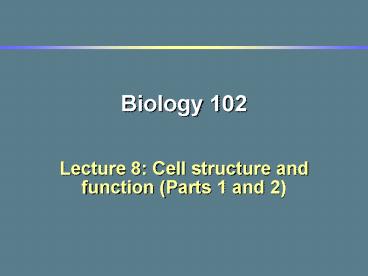Biology 102 - PowerPoint PPT Presentation
1 / 29
Title:
Biology 102
Description:
Created optics that could visualize single cells. His ... Caused by assembly, disassembly and sliding of the filaments. Organelle movement. Ex: Endocytosis ... – PowerPoint PPT presentation
Number of Views:35
Avg rating:3.0/5.0
Title: Biology 102
1
Biology 102
- Lecture 8 Cell structure and function (Parts 1
and 2)
2
Lecture outline
- History of cell study
- Basic attributes of cells
- Cell structures
3
I. The history of cell study
- Robert Hooke1665coined the word cell, looked at
cork cells - Antonie van Leeuwenhoek
- Created optics that could visualize single cells
- His technology lost for nearly 200 years
- C. Robert Brown1831discovered the "nucleus"
4
I. The history of cell study
- D. Theodor Schwann1838viewed animal cells in
cartilage - 1. Cells are the elementary particles of plants
and animals - E. Mattias SchleidenCells are the fundamental
basis of life - F. Virchow1858All cells come from cells
5
I. The history of cell study
- F. Cell theory
- All living things are composed of one or more
cells - What about viruses?
- 2. Cells are the basic unit of structure and
function - 3. All cells come from preexisting cells
6
II. Attributes of cells
- A. Cell size
- 1. 1100µm
7
II. Attributes of cells
- 2. Why is there a limit to cell size?
- a. Surface-to-volume ratio
- b. Distance from surface to center
8
II. Attributes of cells
- B. Cell types
- 1. Prokaryoticno nucleus (or other
membrane-bound organelles) circular DNA,
ribosomes
9
II. Attributes of cells
- B. Cell types
- 2. Eukaryoticlarger, nucleus, linear
chromosomes, membranous organelles
10
(No Transcript)
11
III. Cell structure
- A. All cells (prokaryotes and eukaryotes)
possess a plasma membrane, cytoplasm, genetic
material and ribosomes - 1. Plasma membrane has phospholipid bilayer,
embedded glycoproteins - a. Isolates cytoplasm from environment
- b. Regulates molecular movement into and out of
cell - c. Interacts with other cells/environment
12
III. Cell structure
- A. All cells possess a plasma membrane,
cytoplasm, genetic material and ribosomes (cont.) - Genetic materialDNA, found in the nucleus (of
eukaryotes) - Within cytoplasm of prokaryotes
- 3. Cytoplasmwater, salts, organic monomers and
polymers - a. Contains organelles
13
III. Cell structure
- B. Organelles
- 1. Ribosomes assemble amino acid monomers into
polypeptide chains - a. Associated with the ER in eukaryotes
- Composed of RNA and proteins
- Both prokaryotes and eukaryotes have ribosomes
- NOTE Other organelles are present only in
eukaryotes
14
III. Cell structure
- Organelles (cont.)
- 2. Endoplasmic reticulum consists of folded
membranes contiguous with outer nuclear membrane - Rough ER protein synthesis and secretion
- Smooth ER lipid synthesis and secretion
- Golgi apparatus membranous sacs associated with
the ER - Sorts proteins and lipids by destination
- Modifies some molecules
- Packages these materials, then transports them to
appropriate location - 4. Lysosomes are Golgi-derived vesicles
containing digestive enzymes
15
Flow of membrane within the cell
- Follow pathway of membrane flow
- Nucleus
- ER
- Golgi apparatus
- Lysosomes (and other packets of materials)
- Plasma membrane
16
III. Cell structure
- B. Organelles (cont.)
- 5. Mitochondria provide energy for cellular
functions - Membrane-bound (two membranes)
- Most concentrated in metabolically active cells
(i.e. muscles) - Break down molecules to obtain their energy
- Energy stored short-term as ATP
- c. Have their own DNA and ribosomes
self-replicate
17
Structure of a mitochondrion
- Note Different reactions occur in different
parts of the mitochondrion
18
Plant cells Have all the organelles previously
mentioned, and also
19
III. Cell structure
- B. Organelles (cont.)
- 6. Vacuoles
- a. Large, water-filled spaces (cell sap)
- b. Can take up over 90 of cell volume
- Surrounded by tonoplast (a single membrane)
- d. Functions
- 1) Storage of red/blue anthocyanins, acids,
salts, wastes - 2) Maintain cell pressure (turgor
pressure)wilting
20
Maintenance of turgor pressure
21
III. Cell structure
- B. Organelles (cont.)
- 7. Chloroplasts
- Note double membrane
- Greencontain chlorophyll pigment
- Stacks of thylakoids (grana) within stroma
(fluid) - As for mitochondria, diff. parts have diff.
functions - Have their own DNA and ribosomes self-replicate
22
III. Cell structure
- B. Organelles (cont.)
- 8. Other plastids
- Storage of materials such as pigments and starch
(as in potatos)
23
III. Cell structure
- B. Organelles (cont.)
- 8. Nucleus is control center of the cell
24
III. Cell structure
- B. Organelles (cont.)
- Functions of the parts of the nucleus
- Nuclear envelope (membrane) with pores
- Water, ions and ATP can pass through pores
- Other materials are regulated by gatekeeper
proteins in the pores - Nucleolus
- Site of ribosome assembly
- Chromatin
- Between nucleolus and envelope
- DNA and protein (not in nucleolus!)
- Replication and transcription
25
III. Cell structure
- C. Cell walls in plant cells, prokaryotic cells,
fungi - Plants
- Cell walls of cellulose (Ch. 3)
- Fungi
- Cell walls of chitin (Ch. 3)
- Function support, protection
- NOTE Animal cells do not have cell walls!
26
III. Cell structure
- Cytoskeleton
- Network of protein fibers to which organelles and
even enzymes are attached - Microfilaments Intermed. Fil.
Microtubules
27
III. Cell structure
- Cytoskeleton functions
- Cell shape
- Organization of cellular structures
- Cell movement
- Caused by assembly, disassembly and sliding of
the filaments - Organelle movement
- Ex Endocytosis
- Movement of membrane from ER to Golgi apparatus,
etc - Cell division
28
III. Cell structure
- E. Cilia and flagella are protein microtubule
extensions of the plasma membrane - Cilia short and numerous
- Examples within oviducts to move eggs,
filter-feeding in invertebrates, movement of
particles out of respiratory system
29
III. Cell structure
- 2. Flagella longer and fewer































